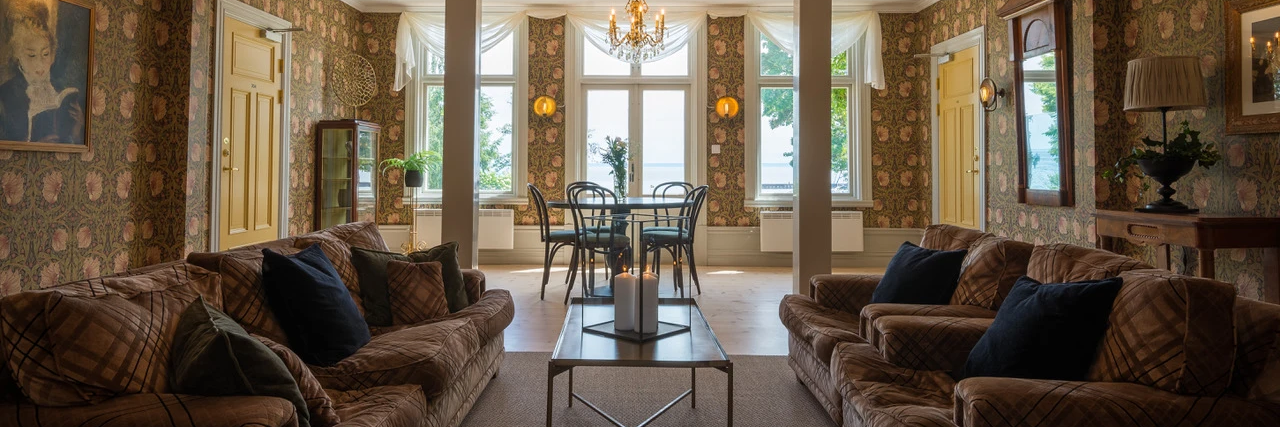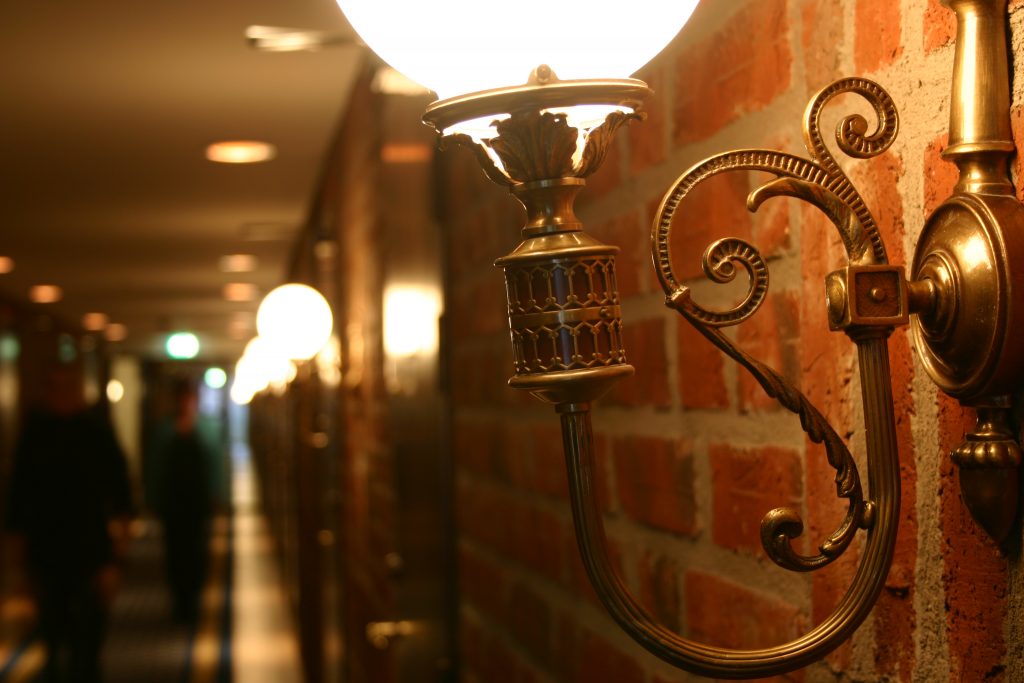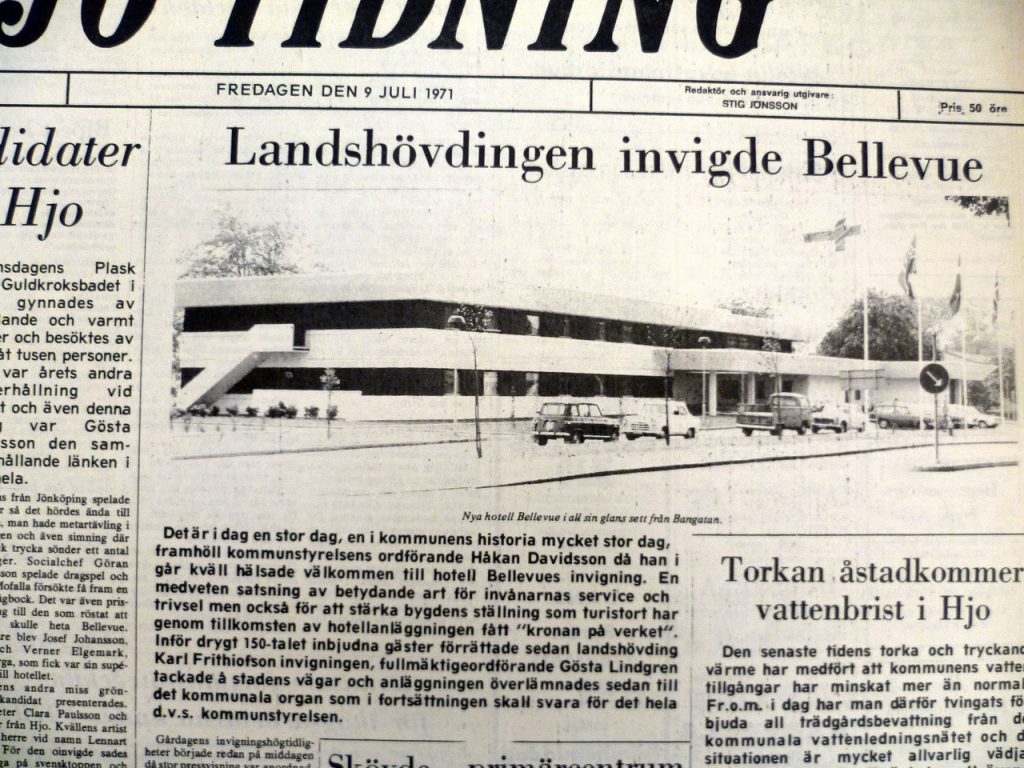





Site facs
Number of rooms: 66
Number of beds: 129
Smokefree: Yes
Pet Friendly: Yes, selected rooms
Free outdoor parking: Yes
Wireless Internet: Yes
Relax: Yes, with sauna
Pool: Yes, in summer season
(municipal-owned outdoor swimming pool)



Hotel Bellevue, which stands on the site today, was built and completed on Midsummer’s Eve 1971, but the journey begins well much earlier than that, namely 1884 ..
1884 Namely, Hjo Vattenkuranstalt AB bought the Järnvägshotellet which was located on Bellevueterassen, the bulge on the gravel field towards the water you can see today. It was built in 1873 and was also called the bathing restaurant, with its stately wooden porches and balconies and a fantastic view of the lake, it became popular with both locals and spa guests.
On August 28, 1932, the last night of the season, Hotel Bellevue burned down. Hjo at that time had another Hotel Royal in the city center, the political blocs did not come to an agreement to rebuild it despite discussions.
It was not until the 1960s, when the railway was closed, that new opportunities arose to place a larger hotel adjacent to the city park. In October 1968, Hotel Royal was in financial trouble and the hotel issue was investigated again at the town hall when they threatened to close it.
the winter season which would mean a great deal of damage, to established associations and groups housed in the hotel.
Opinions about renovating Hotel Royal or building a brand-new hotel were divided, but in the end it was agreed that building a new one was the solution.
In September 1969, the architect Hans-Erland Heineman was hired to completely design the new hotel. Heineman, who had his office in the neighboring town of Skövde, was a locally known architect who received a lot of media attention.
The new hotel building was calculated for a two-storey building with a restaurant for 150 people, a bar for 100 people and for the 22 guest rooms and economy parts. During the summer of 1970, the railway station was demolished and construction of the new hotel began. In October of the same year, it became clear that cellar master Olof Haglund from Orsa would take care of operations in the now renamed Hotel Bellevue.
In the mid-1970s, there were requests to expand the hotel, among other things to meet the demand for conference facilities. Hotel Bellevue was in some cases forced to refuse requests from larger groups as the standard of the park villas could not meet the requirements that the participants placed on modernity, including a shower in the room. In addition, there was a shortage of conference facilities.
In 1977, another 28 rooms and conference rooms were built, including those designed by Hans-Erland Heineman. Heineman drew much of his inspiration from his colleague Frank Lloyd Wright.
Hotel Bellevue was a popular venue for its dance evenings and conference facilities during the 1970s & 80s. Artists such as Lill-Babs, Sven-Ingvars and the Vikings have performed in the large dining room. The business was hit hard during the financial crisis and with several changes of ownership, the operation, with more or less successful maintenance, finally collapsed in the autumn of 2009.
From here, our real journey began, in the spring of 2010, after the hotel had been empty all winter, it was taken over by the current management to be rebuilt. This time as a travel destination for tourists and conference activities.



Aktiebolaget Hjo Vattenkuranstalt was founded in December 1876 by several Hjo residents: landowner Harald Röhss in Munkeberg, Count Gustaf Sparre in Almnäs, wholesaler Gustaf Sjöstedt, Alexis Sparre, C.J Fogelin, G. Rhodin and A. Johansson. They bought a country estate, what we know today as Hjo Stadspark. People went here for their social health and socialized with like-minded people. The married young people may have met their life partners here, during the parents’ conversation about their excellence.
However, it was not long before this, like many other resorts that emerged during the same period, that the hotel gained the character of a holiday resort for the growing bourgeoisie.
In 1882, Villa Viktoria was built, designed by P.A Pettersson from Värsås, when more residential buildings were needed for Kurorten’s guests. Viktoria, together with its neighboring villas Idun, Flora, Götha and Guldkroken which belonged to the health resort, are built with enormous carpentry joy and their own distinctive features.
Here, along Lake Vättern, the wooden villas line up and remind us of the times gone by when guests visited the bathing establishment to cure their ailments. Nowadays, hotel rooms, kindergartens, artist studios, apartments and hostels are housed in the villas.


Vi använder cookies och liknande tekniker för att kunna förbättra din användarupplevelse och för nedanstående ändamål. Du kan här välja att acceptera samtliga cookies eller anpassa vilka cookies du accepterar eller inte. Läs gärna med om hur Google använder din data på Google’s Privacy & Terms site